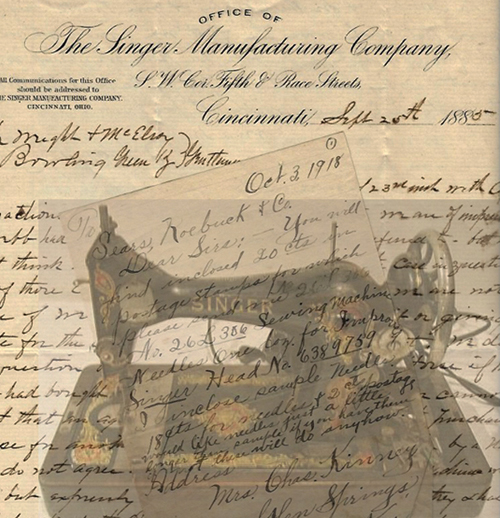
On this June 13, National Sewing Machine Day, we remember the 19th-century English, French, German and American inventors who alleviated (or at least revised) the toil of the tailor and seamstress. We also remember the millions of women who saw their employment and domestic lives transformed by the new technology.
Early in 1861, Sallie Knott had much to write about from Missouri to her mother in Bowling Green, including the election of Abraham Lincoln that had ignited talk of secession. Also of note, however, was her friend’s new Grover & Baker sewing machine. “I’ve learned to sew pretty well,” Sallie reported. “It only cost $45 & answers pretty well when there is no stout jeans for servants.” She had run up a calico dress in only one day, and was quickly losing interest in sewing by hand. “It spoils one very soon,” she admitted. “I dislike to take up any needle now to do anything – even to baste.”
Whether at home or in the workplace, women were quick to find that like much new gadgetry, the sewing machine pushed them to perform more labor in the same time rather than the same labor in less time. “Lizzie sews every day,” a correspondent reported to her cousin from Bourbon County in 1870. “She has a Wheeler & Wilson machine, and has all the sewing she can do.” The machines also required a new technical language for parts and maintenance. “Send me No. 26L306 sewing machine Needles one doz. for Improved Singer Head No. 6389759,” wrote Lewis County, Kentucky’s Annie Kinney to Sears, Roebuck in 1918. Her efficient requisition was accompanied by a sample needle and a preference for ones “just a little longer,” if possible.
On its way to becoming synonymous with the sewing machine, Isaac Merritt Singer’s company developed a mass marketing strategy for women who sewed at home. In 1885, Singer wrote from its Cincinnati office to Bowling Green lawyer Clarence McElroy about one of its local agents on whom it relied to sell machines, parts and accessories. J. C. Webb had signed on as a full-time agent in 1880, receiving a salary of $15 per week plus a 3% commission on sales. His contract also stipulated that he was “to furnish one Horse to be used in the business and to pay for its keeping.” Webb, however, had attempted to buy his horse in the company’s name, making Singer responsible for payment. While reluctant to make a scene, the Singer representative was firm in his instructions to McElroy. “We do not question our obligation to pay for a Horse if Mr. Webb had bought it for the use of the company, but we cannot admit that an agent has a right or authority to purchase a Horse for another party and bind the company by a note.” Besides, he pointed out, there was the matter of that clause in the contract – prepared, as it happened, on another newfangled device, the typewriter.
Click on the links to access finding aids for these collections in the Manuscripts & Folklife Archives of WKU’s Department of Library Special Collections. For more, search TopSCHOLAR and KenCat.
